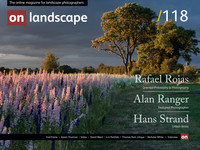
Oriental Philosophy & Photography
Art and philosophy are tightly intertwined. Contrary to science, where we try to find answers to questions, art and philosophy look for more questions. Finding the answers to these questions might be a welcome result, but the importance is the questioning process itself rather than the answers. more

Darren Ciolli Leach
He says on his website that as a visual person he finds it difficult to express in words what taking photographs means to him, but he kindly agreed to give it a go for On Landscape. more

Compositional Controversies
Today, it is hard to imagine any aspiring landscape photographer making an inroad into the medium without stumbling over the “Leading Lines” mantra sooner rather than later. more

The Importance of Context
Can you appreciate both a good novel and a good piece of journalism? How about a good poem and a good guidebook? Why is it that many are so resistant to accommodating multiple uses for photography as they do for writing more
Silent Landscape – Battlefields of The Western Front
There are many books about the human experience and tactics of The Great War, but this one is different: it is an illustrated book about the landscape upon which the war was fought, relentlessly, over a narrow ribbon stretching across Northern Europe. All the explosive and destructive power known to man was used here, with success or failure being measured in yards rather than human cost. Time and again, battles were fought over the same ground until finally the more

Endframe: “Maple and Birch Trunk & Oak Leaves” by Eliot Porter
Almost all the other photographs were obvious subjects – mountains, rivers, etc – photographed in more or less bombastic style. This was a more subtle shot; small trees in a dense woodland arranged all on top of each other in the middle of the frame. more

Black & White
If I did not have to make my living from photography, I would only stick to black & white. There is so much more freedom in black & white than in colour. more

The History of Moonlight
I have never understood anybody who seems disinterested in the night sky and this fascination to photograph it began on Dartmoor, right at the start of my love for photography. more
“Iceland – An Uneasy Calm” by Tim Rudman
In issue 112 we had an interview with Tim Rudman about his Iceland exhibition and book and promised to have a review of the book in the following issue. Hopefully, you’ll forgive us for being a little late on this but the good news is that it’s worth the wait! I think Tim will agree with me if I say he’s something of a perfectionist. And when a perfectionist collides with the world of book publishing, there will undoubtedly be more

Iceland – The Inspiration for the Book
Hans Strand talked at the Meeting of Minds Conference 2014 about the inspiration for his book Iceland. more

Clipping Colour
Whilst taking some test shots in my front garden last week, I noticed something strange going on. It wasn't a problem capturing the images, I remember taking a normal exposure and then taking +1 and +2 brackets and the +2 bracket was obviously clipped on the back of the camera (as shown below). Knowing that the camera clipping indicator lies, I imported the images into Lightroom, set the more

Compositional Controversies
Debate has often raged between photographers, about the advantages and characteristics of specific aspect ratios. I know that, having listened (and contributed) to a few such debates over the years. And yet, how significant is aspect ratio, and is it meaningful to us as we develop our photography? more

Rolling Stones, Norwegian Wood and some others
In 1990 I visited the Ansel Adams Gallery in Yosemite National Park. I was eager to see some powerful American landscape photographs. In their collection of work by the American masters, they had several dye transfer prints by Eliot Porter and for very decent amount of money. However at this time in my life I was not ready for Eliot Porter. I simply did not appreciate the subtle content of his intimate landscapes. more

Tim Rudman – Iceland Exhibition
Last year I was contacted by Tim Rudman about scanning some darkroom prints for a book project he had in mind. I owned a couple of books by Tim and also had seen some of his work on his website and so was quite intrigued by the project. more

Conflicts of Interest
To anyone who wishes to elevate their experience of photography beyond simply seeking pretty places and checking known compositions off a list, my advice is this: find places and subjects that are personally meaningful to you, and immerse yourself in getting to know them. more

